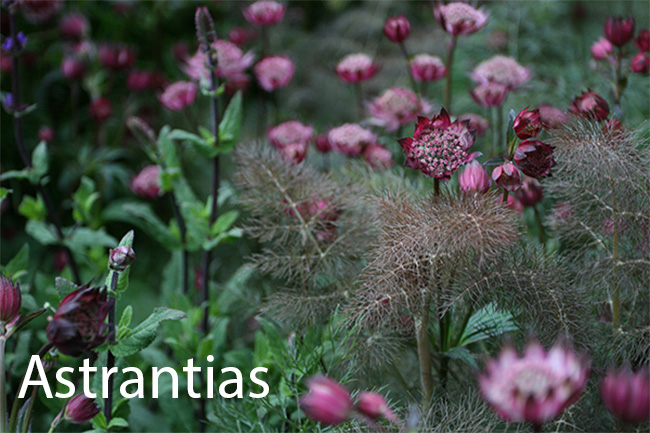|
There’s another group of pollinating insects on the wing in high summer, the hoverflies. They resemble small wasps but don’t sting, and they also feed on nectar and pollen. They’re true flies, not bees or wasps, and they have one pair of wings. However hoverflies also have a small club-like structure, called a halter, and this acts like a gyroscope so they have incredible control over their flight, literally hovering in the air. They lay eggs and the larvae of most hoverflies in your garden devour aphids, so they’ll pollinate and control your pests.
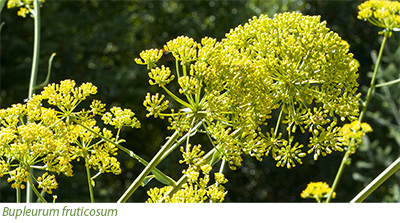
Hoverflies need nectar and pollen, just as bees do, but they have much smaller mouthparts, so they have a preference for tiny flowers, the ones bees tend to ignore. Umbellifers are perfect for them and any cow parsley arrangement of small flowers, arranged on an upside-down umbrella of radiating stems, will attract hoverflies and flies. Both make excellent pollinators. Among the best, long-lived umbellifers are Selinum wallichianum, dubbed the Queen of Umbellifers by the revered gardener Edward Augustus Bowles (1865 – 1954). This late-summer flowering perennial has flat heads of white flowers and highly divided bright green foliage. The shrubby Bupleurum fruticosum provides a roundel of olive-green leathery foliage topped by an August explosion of lime-green heads. Both should grace every garden.
 Not all umbellifers follow the upside-down umbrella format though and eryngiums and astrantias are also members of the umbellifer family - although they don’t look like it! On close examination astrantias have tiny flowers on short stalks enclosed by a ring of bracts, reminiscent of a hand-tied posy surrounded by crimped paper. One common name is Hattie’s pincushion and astrantias have been grown in gardens for centuries as a potherb and the 17th century writer William Cole mentions Astrantia major in The Art of Simpling published in 1656. This ‘mighty plant’ (as he called it) enabled anybody who wore it round their neck to ward off evil spirits and become more powerful - hence the other common name of masterwort. Not all umbellifers follow the upside-down umbrella format though and eryngiums and astrantias are also members of the umbellifer family - although they don’t look like it! On close examination astrantias have tiny flowers on short stalks enclosed by a ring of bracts, reminiscent of a hand-tied posy surrounded by crimped paper. One common name is Hattie’s pincushion and astrantias have been grown in gardens for centuries as a potherb and the 17th century writer William Cole mentions Astrantia major in The Art of Simpling published in 1656. This ‘mighty plant’ (as he called it) enabled anybody who wore it round their neck to ward off evil spirits and become more powerful - hence the other common name of masterwort.
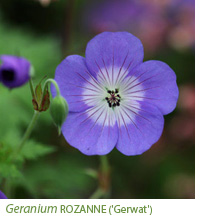 Astrantias begin flowering in May and for this reason they have often been used at the Chelsea Flower Show. Deep red astrantias vary in tone, from wine-red to black-red, and they can all look sombre in the garden. Another common name is melancholy gentlemen and that suits these deep-reds well. They need a brighter partner to shine and the designers Arne Maynard and Piet Oudolf created an iconic Chelsea Show Garden in 2000 using cloud-cut box hedging, red astrantias and the deep blue Salvia nemorosa 'Caradonna'. You could also use a true-blue hardy geranium that starts flowering in May and ‘Orion’ would be perfect. ‘Rozanne’, although equally desirable, wouldn’t work because it’s a paler-blue which flowers in the second half of summer. They simply wouldn’t coincide. Astrantias begin flowering in May and for this reason they have often been used at the Chelsea Flower Show. Deep red astrantias vary in tone, from wine-red to black-red, and they can all look sombre in the garden. Another common name is melancholy gentlemen and that suits these deep-reds well. They need a brighter partner to shine and the designers Arne Maynard and Piet Oudolf created an iconic Chelsea Show Garden in 2000 using cloud-cut box hedging, red astrantias and the deep blue Salvia nemorosa 'Caradonna'. You could also use a true-blue hardy geranium that starts flowering in May and ‘Orion’ would be perfect. ‘Rozanne’, although equally desirable, wouldn’t work because it’s a paler-blue which flowers in the second half of summer. They simply wouldn’t coincide.
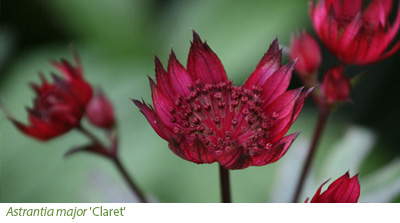
Red astrantias need fertile soil to do well and they will grow in dappled shade. The dryopteris and red astrantia combination is eye catching in spring. You could use both in a woodland position, although not dry shade, or plant them along a shady stream bank above the water line. A good named form is ‘Claret’, which has a wine-red pincushion surrounded by deep red bracts framed by dark foliage. ‘Claret’, which was named by Dutch plantsman Piet Oudolf, is a warm red that arose as a rare seedling from the darker ‘Hadspen Blood’, a ruby-red astrantia named in the early 1990s by Nori Pope who gardened at Hadspen House in Somerset between 1986 and 2005. It’s a desirable plant because it doesn’t normally set seed.
Seeds can be a problem with some astrantias so it’s always a good idea to cut off spent red astrantia flowers to prevent inferior seedlings popping up. Astrantia seed heads also tend to brown badly as they age and this looks unsightly. If deadheaded, most red astrantias will produce some more flowers in September, although not as generously as they did in May.
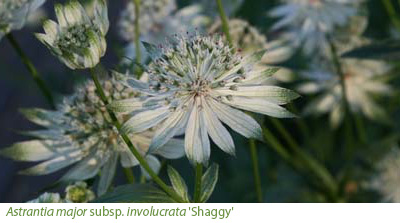
The inconic white astrantia, Astrantia major subsp. involucrata ‘Shaggy' has white flowers surrounded by green-veined bracts. Grown well and given good soil, it’s a stunner because the uppermost flower becomes an enormous ragged affair with white bracts tipped in green. This settling in process takes time, but ‘Shaggy’ is worth the effort so give it three years to really get going. The name came from Margery Fish (1892 – 1969), who grew many astrantias in her Somerset garden - East Lambrook Manor. She first saw it in cottage gardens in Gloucestershire and the true form has long bracts that twist at the ends.
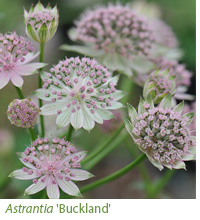 Some paler astrantias are much neater and completely sterile and as a result they flower over many months. ‘Buckland’ will begin in April and carry on until July, before the flowers begin to brown and fade. In good soil this green-leaved astrantia makes large clumps, probably because it can’t set seed, and it can produce hundreds of silver-pink flowers edged in green-veined bracts. ‘Buckland’ will grow in full sun and in drier conditions and it’s an excellent filler on the sunny side of a herbaceous border, or with darker roses. It also wins the prize for being the longest flowering astrantia of all. It was discovered by Keith and Ros Wiley at The Garden House in Buckland Monachorum in Devon, well over twenty years ago, and ‘Buckland' shimmers like a silver thread in any garden. Some paler astrantias are much neater and completely sterile and as a result they flower over many months. ‘Buckland’ will begin in April and carry on until July, before the flowers begin to brown and fade. In good soil this green-leaved astrantia makes large clumps, probably because it can’t set seed, and it can produce hundreds of silver-pink flowers edged in green-veined bracts. ‘Buckland’ will grow in full sun and in drier conditions and it’s an excellent filler on the sunny side of a herbaceous border, or with darker roses. It also wins the prize for being the longest flowering astrantia of all. It was discovered by Keith and Ros Wiley at The Garden House in Buckland Monachorum in Devon, well over twenty years ago, and ‘Buckland' shimmers like a silver thread in any garden.

‘Roma’ runs it a close second though for length of flowering and it’s probably the most vigorous. This deeper pink astrantia, a sterile seedling from ‘Ruby Wedding’, was named and selected by Piet Oudolf in the 1990s. It’s perfect for weaving through prairie planting because it’s a strong, almost candy pink that picks up the colour of dusky pink echinaceas and asters. It needs good soil to do well. ‘Penny’s Pink’, a new astrantia with clear pink flowers and bracts touched with green, has filled a gap because it’s a good colour - combining that strong pink with subtle green and white touches.
Whichever one you grow, you can guarantee that your astrantias will be worshipped by hoverflies, those acrobatic creatures, who create their own summer heat haze. |
Things to do
 |
Remove spent flowers
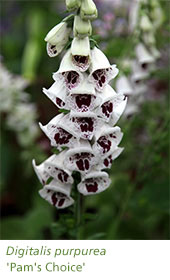
Keep the summer going by snipping away spent flowers and removing any hints of brown from the borders. You may want to collect seeds from some early-flowering prolific annuals or biennials that have finished, eg. opium poppies and foxgloves. Leave two or three plants intact, but remove the rest, and collect the seeds when ripe. You can sow then straight away, or keep the seeds until next spring.
|
 |
Give things a trim

Cut back billowing nepetas, such as ‘Six Hill’s Giant’, and prolific hardy geraniums that began flowering in early summer. ‘Patricia’ and ‘Orion’ will develop new foliage almost immediately and re-bloom in six to eight weeks - giving you later flowers.
|
 |
Keep on feeding

If you’ve got summer bedding in containers, feed them every two weeks by watering on tomato feed. This potash-rich mixture encourages more flower and toughens up the foliage.
|
 |
Be water wise
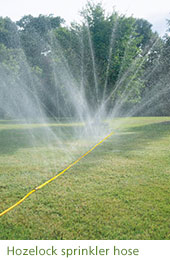
Water in the mornings or late afternoons. This promotes better growth because the temperatures are lower, so less water evaporates.
|
 |
Keep crops productive
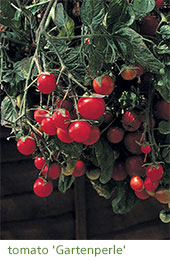
If you’re off on holiday try to get a kind neighbour or friend to harvest your pickable vegetables, such as courgettes, tomatoes and beans. If they aren’t picked, your crop will stop producing food.
|
|
|
Essential Kit for July

Mini barbecue
139.99£111.99

Garden deck chair - taupe
39.99£31.99
|
|



